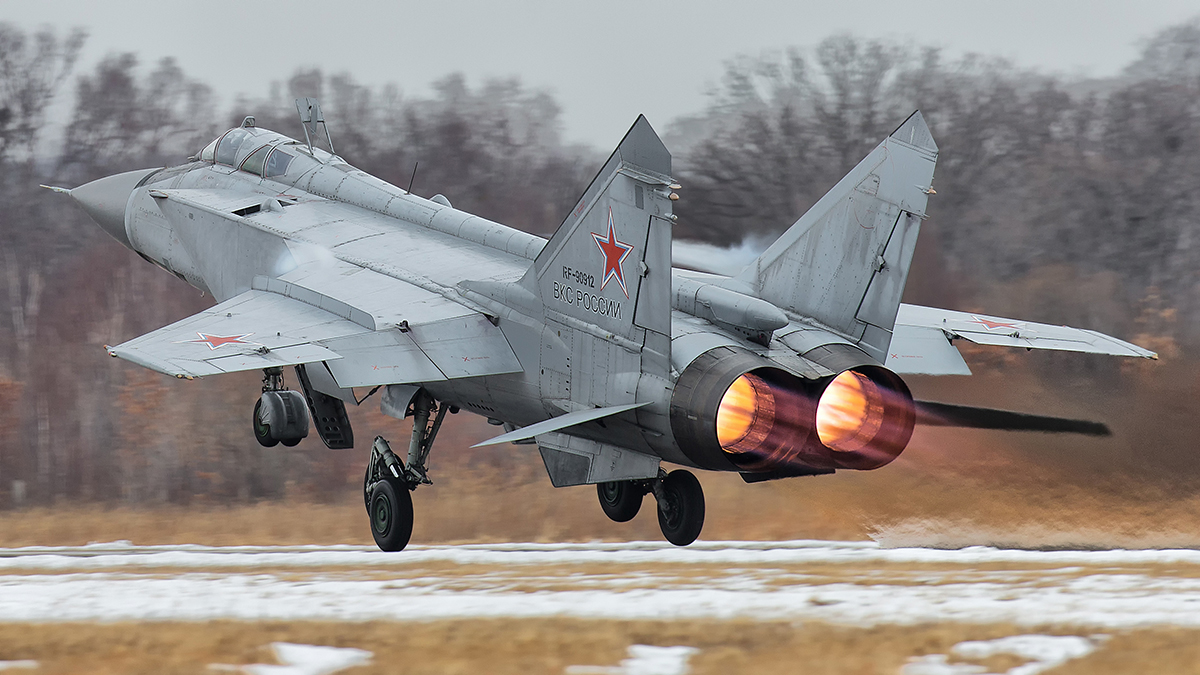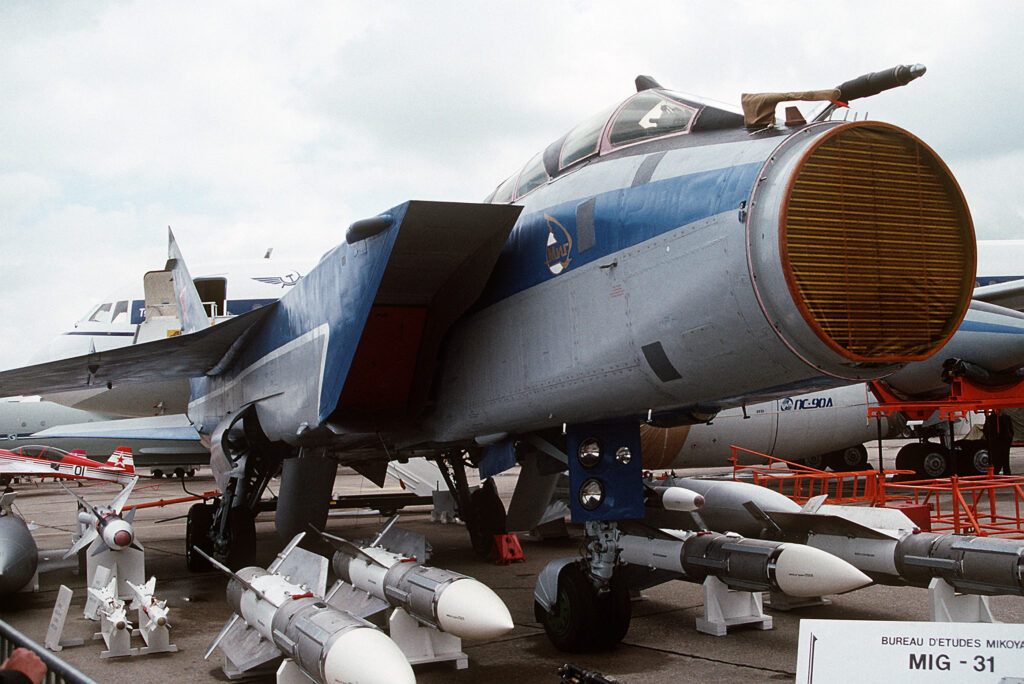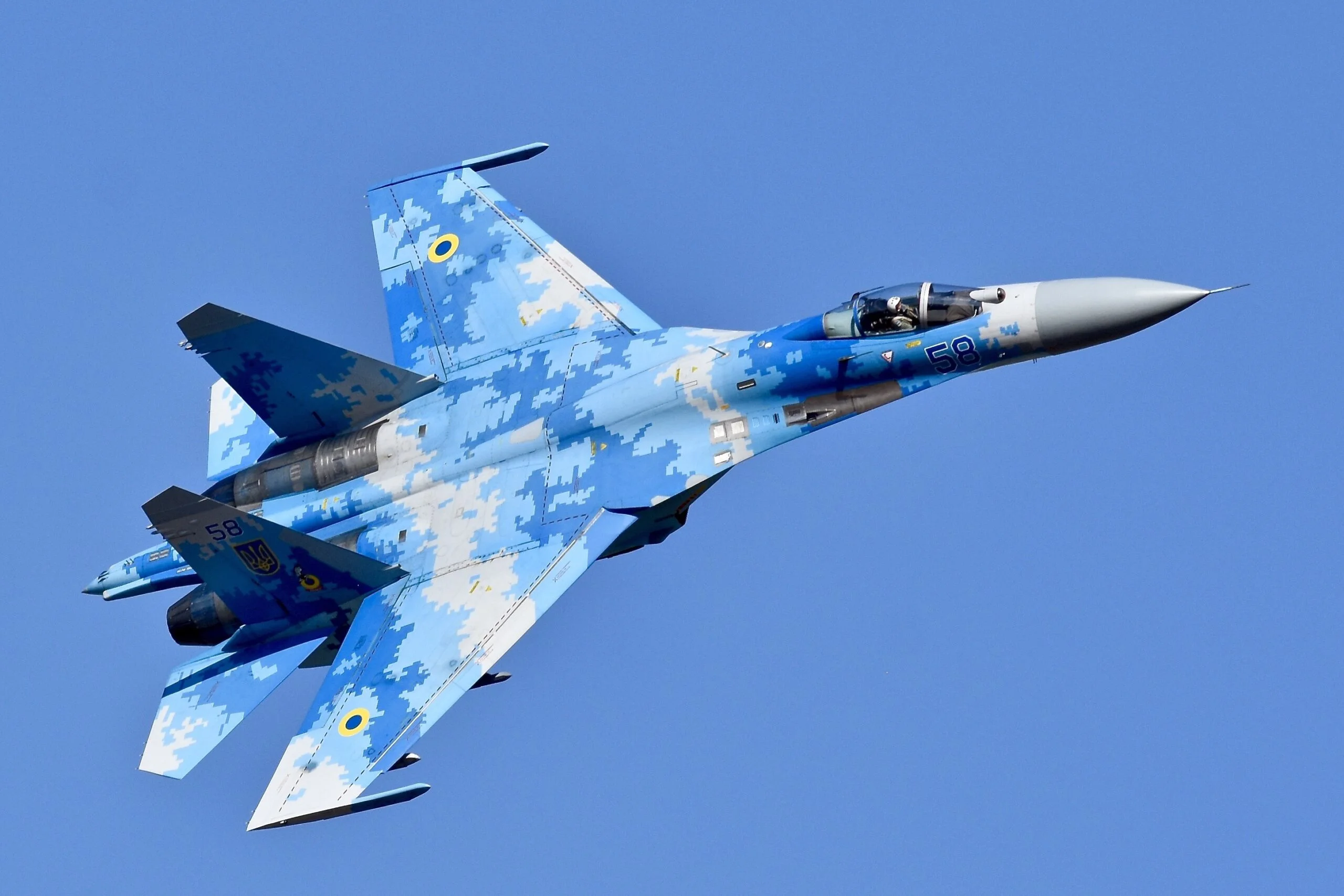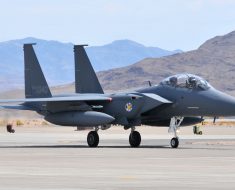The MiG-31, nicknamed Foxhound by NATO, was developed as part of a Soviet program to counteract the threat of NATO low-level strike aircraft and cruise missiles. It was intended to act as a replacement for the MiG-25 Foxbat high-altitude interceptor.
The MiG-31 is the second fastest combat jet to enter military service in the world, and still remains one of the principle planes of the Russian Air Force, being frequently called upon in their invasion of Ukraine, and is set to retire well into the 2040s.

Contents
Development
The MiG-25 that the Foxhound was set to replace had several disadvantages that the Soviets were hoping to rectify. It was unable to fly at low altitudes, and its ineffective turbojet engines meant it had a limited combat range at supersonic speeds. Another common problem was that if the speed increased too much the engines tended to fail.
Read More: Curtiss XP-55 Ascender – The Flawed Fighter
The MiG-31’s initial prototype was called the Ye-155MP, which made its first test flight in 1975. Production of the final model began in 1979, and by 1982 it had begun serving in the Soviet military as part of the Soviet Anti-Air Defense regiment.

By 1985, the Soviets were working on the MiG-31M, an updated model that could shoot long-range R-37 missiles up to 200 km as well as R-77 medium-range-air-to-air missiles.
It was also fitted with a Zaslon-M radar, new avionics systems, better displays in a revamped cockpit, and stronger D-30F-6M engines. Unfortunately, due to budget constraints towards the end of the Soviet Union, the MiG-31M never actually entered the production line.
In 1990 the next edition was designated the MiG-31B and featured an improved Zaslon-M radar alongside brand-new digital processors, superior avionics, and improved electric countermeasure capabilities.

It could also fire off advanced R-33S air-to-air missiles. All existing aircraft that were upgraded to this type were renamed MiG-31BS.
Following this, an anti-satellite version called the MiG-31D, recognizable by its large vertical fins at the wing tips, was also specially crafted and able to carry only a single anti-satellite missile.
During the 90s, the Russians attempted unsuccessfully to build several export versions. Only one MiG-31E Interceptor, installed with downgraded radar software, was ever created, being exhibited only once at the Berlin Air Show in 1992.

In the same vein, the MiG-31FE was planned to be a commercial version of the proposed MiG-31F, a multi-purpose fighter with ground attack abilities, but it never even entered production.
At the same time as the Russians were struggling to make a profitable MiG-31 they could put on the market, they were also enhancing their domestic fleet. The MiG-31BM was first introduced in 1998 and built upon the failed MiG-31F concept of the mid-1990s.
Being the first edition to have ground attack capabilities as well as the ability to perform long-range interceptions, precision strikes, and defence suppression objectives, it was marketed as the first truly multi-operational MiG to see the light of day.

In addition, this exciting new prototype featured advanced displays in the cockpit enabling operators to discharge precision-guided missiles, helped by a Zaslon-AM radar with improved range.
This further gave the MiG an additional function as an early warning aircraft, which could communicate radar positions via datalink to multiple sources, and also as an airborne command unit that could orchestrate the movements of aircraft that had less powerful radar technologies.
In total, those updated to the MiG-31BM standard could increase their operational life by a further 15 years. By 2017, 110 of Russia’s 300 interceptors had been updated to the MiG-31B and MiG-31BMS editions.

Addressing the slow pace of modernization, Russia’s Defense Ministry announced in July 2020 a further life extension program for the Mig-31 Foxhounds.
Read More: Bristol 188 – Britain’s Botched SR-71
Lastly, another modern variant called the MiG-31K also exists and is uniquely modified to carry Kh-47M2 Kinzhal air-launched hypersonic cruise missiles, which can travel at Mach 10 speed and have a range of 2,000 km. By 2010, 10 MiG-31s had been upgraded to this type.
The MiG-31 Foxhound
The MiG-31 Foxhound, designed to intercept enemy planes and missiles, has a length of 22.69 m, a height of 6.15 m, and a maximum take-off weight of 46,000 kg, making it the heaviest combat jet ever constructed for air-to-air combat.
It is incredibly aerodynamic with a streamlined body intended to fly at low altitudes with high speed. The fuselage, which has a long pointed nose, has been fashioned to accommodate lateral rectangular and diagonal cut air intakes, while the exhausts extend beyond the tailplane.

The airframe is composed of 49% nickel steel, 16% titanium, 33% aluminum alloy, and 2% composite materials.
The wings are sharpened and swept back in delta wing style with square tips and a negative slant, providing a boost of up to 25% more lift than the MiG-25. Placed beneath the wing are 4 underwing pylons as well as fuel tanks that can carry a total volume of 5,000 liters.
They feed two Solovyev D-30F6 turbofan engines which each have a takeoff thrust of 15,500 kgf and give it a top speed of around 3 Mach. Adding to this, the MiG-31 can climb at a rate of 208 m per second and has a ferry range of 3,300 km and a combat range of 720 km.

The MiG-30 Foxhound is manned by a crew of two including a pilot and a weapons system officer who both reside in a cockpit that has state-of-the-art digital avionics systems, such as liquid crystal displays or LCDs, which provide clear instrument and radar readings.
The MiG-31 is indeed a technological marvel, equipped with an N007 Zaslon radar, which in its most modern iteration can scan up to 200 km ahead, behind, and below, and can engage up to 10 targets at the same time and attack 4 simultaneously if they are flying within its radius.
The Zaslon is operated by the weapons system officer who sits in the rear cockpit, and it can also be used to receive signals from early warning radar as well as airborne warning and control systems.

It employs a radio antenna that can be moved electronically via digital processing signalling, which means it is faster and more accurate than mechanical steering. The electronic system also means that the antennae can use the full diameter of the fuselage to maximize operational range.
The MiG-31 is incredibly sensitive to its surroundings, being engineered with several advanced sensor systems. It has a track-while scan (TWS) radar which enables it to detect radar devices emitting radio waves in the air or on the ground, and an infrared search and track (IRST) system which gives it the ability to pick up infra-red rays produced by jet aircraft and helicopters.

Moreover, the radar warning receiver (RWR) system can alert the operator of incoming planes with programmed sounds.
Lastly, its Digital Interference communication system enables groups of MiG-31s to share up-to-date tactical information as well as communicate such updates with other planes that have less powerful avionics systems.
The MiG-31 is incredibly deadly as well and has a wide array of weapons at its disposal. It possesses four long-range Vympel R-33 missiles, which can be discharged in inertial navigation mode for targets who occupy the most extreme ranges.

Alternatively, they can be put in semi-active radar homing mode (SARH) which guides the missile to its mark and even provides mid-course updates. R-33s are the perfect choice to take down large, high-speed craft such as the SR-71 Blackbird, the B-1 Lancer bomber, and the B-52 Stratofortress.
The MiG-31 also carries four short-range R-60MK missiles, two Bisnovat R-40TD1 medium-range missiles, and if necessary can equip the AA-12 Adder missile and various Russian-made air-to-ground missile including the AS Krypton anti-radiation missile.
To top it all off, it has a built-in six-barreled 30 mm cannon called a GSh-6-23 gun, located above the starboard main landing gear bay, that has an ammunition capacity of 8000 rounds and can be fired at a rate of over 10,000 rounds per minute.

Service
In total, 519 MiG-31s have been produced, and at least 300 still serve in the Russian Air Force acting as the main arm of their aviation defenses. Kazakstan remains the only former Soviet Republic to inherit the MiG-31, with a squadron of 30 based at Semipalatinsk.
Read More: AH-64 Apache – Overwhelming Firepower
In 2007, Russia’s United Aircraft Corporation (UAC) reportedly signed a contract worth 1 billion dollars with the Syrian government, 400 million of which was earmarked to fund a total of 8 MiG-31s for the government of Bashar-al-Assad.

The order, however, was cancelled in May 2009 because of pressure from Israel and a lack of funds.
In general, the MiG-31 has not been a commercial success for Russia despite being a reliable part of their air force. It has seen action in the Russo-Ukrainian war, completing its first mission on March 18th, 2021, when a MiG-31K armed with a Kh-47M2 Kinzhal ballistic missile was used to strike a Ukrainian arms depot situated near the Polish border.
The MiG-41, which will travel at a speed of Mach 5 and use directed energy weapons, is set to replace the MiG-31 Foxhound in several decades’ time.
If you like this article, then please follow us on Facebook and Instagram.
Sepcifications
- Crew: 2 (pilot and weapons systems officer)
- Length: 22.62 m (74 ft 3 in)
- Wingspan: 13.456 m (44 ft 2 in)
- Height: 6.456 m (21 ft 2 in)
- Empty weight: 21,820 kg (48,105 lb)
- Gross weight: 41,000 kg (90,390 lb)
- Max takeoff weight: 46,200 kg (101,854 lb)
- Fuel capacity: 35,550 lb (16,130 kg) internals, plus optional external fuel tanks
- Powerplant: 2 × Soloviev D-30F6 afterburning turbofan engines, 93 kN (21,000 lbf) thrust each dry, 152 kN (34,000 lbf) with afterburner
- Maximum speed: 3,000 km/h (1,900 mph, 1,600 kn) / Mach 2.83 at 21,500 m (70,538 ft)
- Cruise speed: 2,500 km/h (1,600 mph, 1,300 kn) / Mach 2.35
- Range: 3,000 km (1,900 mi, 1,600 nmi) with 4 x R-33E and 2 drop tanks
- Service ceiling: 25,000 m (82,000 ft)
- g limits: +5
- Rate of climb: 288 m/s (56,700 ft/min)







